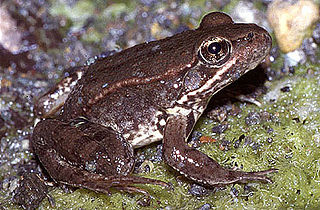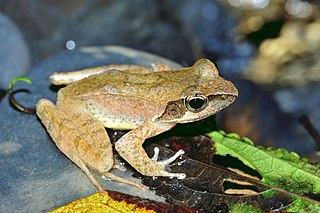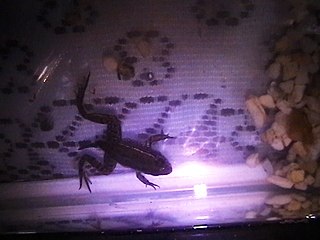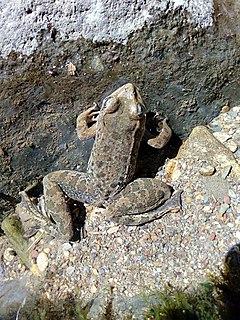
The California red-legged frog is a species of frog found in California (USA) and northern Baja California (Mexico). It was formerly considered a subspecies of the northern red-legged frog. The frog is an IUCN vulnerable species, and a federally listed threatened species of the United States, and is protected by law.

Atelopus is a large genus of Bufonidae, commonly known as harlequin frogs or toads, from Central and South America, ranging as far north as Costa Rica and as far south as Bolivia. Atelopus species are small, generally brightly colored, and diurnal. Most species are associated with mid-to-high elevation streams. This genus has been greatly affected by amphibian declines, and many species are now considered endangered, while others already are extinct. Almost 40% of the described species in the genus are considered possibly extinct; this is raised to 45% when data deficient species are added; this number may be even higher, given that the genus contains many undescribed species that could also be extinct, and many of the species considered critically endangered but extant may have gone extinct after the last surveys that detected them, or could go extinct in the future. While threatened by habitat loss, pollution, and introduced species, the primary cause of these declines appears to be the chytrid fungus Batrachochytrium dendrobatidis. For example, there are 32 known Atelopus species in Ecuador. One of these is data deficient, two are endangered and the remaining are critically endangered. Almost half the Ecuador species have not been recorded in a decade or more and are likely extinct. In some species conservationists have established captive colonies as a safeguard. However, numerous Atelopus species have been rediscovered decades after their last sighting, such as A. arsyescue, A. mindoensis, A. bomolochos, A. ignescens, A. balios, A. longirostris, A. subornatus and A. varius.

The northern red-legged frog is a species of amphibian, whose range is the coastal region stretching from southwest British Columbia to southern Mendocino County in Northern California, and is protected in Oregon and California. As a member of the genus Rana, this species is considered a true frog, with characteristic smooth skin and a narrow waist. This frog requires still waters for breeding, and is rarely found at any great distance from its breeding ponds or marshes.

Rana amurensis is a species of true frog found in northern Asia. It ranges across western Siberia, as well as northeastern China, northeastern Mongolia, and on the northern Korean Peninsula and on Sakhalin. Rana coreana was previously included in this species as a subspecies. Found at latitudes up to 71° N, it is the northernmost wild amphibian species.
Odorrana bolavensis is a species of frog in the family Ranidae. It is endemic to the Bolaven Plateau, Laos. Its natural habitats are wet evergreen forest. It can be found at night on rocks and vegetation along rocky streams, occasionally on leaf-litter or tree branches away from streams.

The common green frog is a frog species of in the true frog family Ranidae; some sources still use the old name Rana erythraea. It lives in Southeast Asia and is also known as green paddy frog, red-eared frog or leaf frog. The last name, however, commonly refers to the Neotropical tree frogs which make up the subfamily Phyllomedusinae. These are not closely related to H. erythraea, belonging to family Hylidae instead.

The Greek stream frog, or simply Greek frog, is a species of frog in the family Ranidae found in Albania, Bosnia and Herzegovina, Bulgaria, Greece, North Macedonia, Serbia and Montenegro, and Turkey. Its natural habitats are temperate forests, temperate grassland, rivers, intermittent rivers, freshwater springs, and pastureland. It is not considered threatened by the IUCN.

Rana sauteri is a species of true frog endemic to Taiwan. It inhabits low-altitude hill forests and the associated streams. It is an endangered species threatened by habitat loss due to agriculture and infrastructure development. Common names recorded for Rana sauteri include Kanshirei Village frog, Taiwan groove-toed frog, Sauter's brown frog, and Taiwan pseudotorrent frog.
The Guatemala plateau frog is a species of frog in the family Ranidae. It occurs in Guatemala and southern Mexico. It is impossible to morphologically distinguish this species from Lithobates forreri and Lithobates brownorum, and the validity of it has been questioned. It is an uncommon frog that inhabits cloud forests, including degraded forest, and grassland. Breeding takes place in streams and small temporary ponds. It is threatened by habitat degradation caused by agricultural encroachment, wood extraction, human settlement, and water pollution.

The highland frog, also known as the masked mountain frog, is a species of frog in the family Ranidae, known from El Salvador, Guatemala, Honduras, Mexico, and Nicaragua. Its natural habitats are subtropical or tropical moist lowland forests, subtropical or tropical moist montane forests, rivers, and freshwater marshes. It is threatened by habitat loss.
The island leopard frog or Little Corn Island frog is a species of frogs in the family Ranidae, endemic to Little Corn Island off the Caribbean coast of Nicaragua. It is locally known as rana leopardo isleña.
The Omei brown frog or Omei wood frog is a species of frog in the family Ranidae. It is endemic to central China. Its name refers to Mount Emei, its type locality. Its natural habitats are hill forests and grass clumps in forests. Breeding occurs in late summer and the tadpoles overwinter; the breeding habitat is standing water. It is not considered threatened by the IUCN.

The showy leopard frog is a species of frog in the family Ranidae endemic to Mexico.

Tlaloc's leopard frog, or rana de Tláloc in Spanish, is a species of frog in the family Ranidae endemic to the Valley of Mexico. It is most likely extinct.

Zweifel's frog is an amphibian species endemic to Mexico. It is a member of the true frog family, Ranidae.

The Korean brown frog is a species of frog in the genus Rana. It is native to the Korean Peninsula and Shandong, China.












